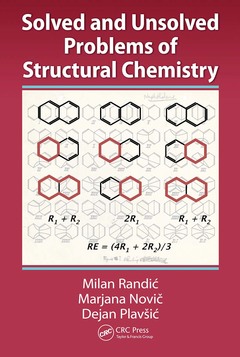Solved and Unsolved Problems of Structural Chemistry
Auteurs : Randic Milan, Novic Marjana, Plavsic Dejan

Solved and Unsolved Problems of Structural Chemistry introduces new methods and approaches for solving problems related to molecular structure. It includes numerous subjects such as aromaticity?one of the central themes of chemistry?and topics from bioinformatics such as graphical and numerical characterization of DNA, proteins, and proteomes. It also outlines the construction of novel tools using techniques from discrete mathematics, particularly graph theory, which allowed problems to be solved that many had considered unsolvable.
The book discusses a number of important problems in chemistry that have not been fully understood or fully appreciated, such as the notion of aromaticity and conjugated circuits, the generalized Hückel 4n + 2 Rule, and the nature of quantitative structure?property?activity relationships (QSARs), which have resulted in only partially solved problems and approximated solutions that are inadequate. It also describes advantages of mathematical descriptors in QSAR, including their use in screening combinatorial libraries to search for structures with high similarity to the target compounds.
Selected problems that this book addresses include:
- Multiple regression analysis (MRA)
- Insufficient use of partial ordering in chemistry
- The role of Kekulé valence structures
- The problem of protein and DNA alignment
Solved and Unsolved Problems of Structural Chemistry collects results that were once scattered in scientific literature into a thoughtful and compact volume. It sheds light on numerous problems in chemistry, including ones that appeared to have been solved but were actually only partially solved. Most importantly, it shows more complete solutions as well as methods and approaches that can lead to actualization of further solutions to problems in chemistry.
Introduction. Mathematical Chemistry. Graph Theory and Chemistry. Characteristic Polynomial. Structure–Activity. Molecular Descriptors. Partial Ordering. Novel Molecular Matrices. On Highly Similar Molecules. Aromaticity Revisited. Clar Aromatic Sextet. Renormalization in Chemistry. Graphical Bioinformatics. Beauties and Sleeping Beauties in Science. Appendices.
Milan Randić earned his PhD from the University of Cambridge, England. He founded the Theoretical Chemistry group at the Institute Rudjer Bošković in Zagreb, Croatia, in 1960. He joined the department of chemistry at the University of Zagreb in 1965 before leaving for the United States. He later joined the department of mathematics and computer science at Drake University, Des Moines, Iowa, until his retirement in 1999 as a distinguished professor. He has won several awards and pays annual visits to the Laboratory of Chemometrics, National Institute of Chemistry, Ljubljana, Slovenia. He is a member of the Croatian Academy of Sciences and Arts, an honorary member of the Slovenian Chemical Society, and an honorary member of the National Institute of Chemistry in Ljubljana, from which he received the Grand Pregel Award in 2010. In 2014 he reported the exact solution of the protein alignment problem, which had existed for 45 years.
Marjana Novic is head of the Laboratory of Chemometrics at the National Institute of Chemistry, Ljubljana, Slovenia, andteaches chemometrics at the University of Ljubljana, where she earned her PhD from the Faculty of Chemistry and Chemical Technology in 1985. She started her career at the National Institute of Chemistry in Ljubljana, initially developing automated information systems for infrared and NMR spectroscopy. Her expertise includes the development of chemometrics methods, QSAR and ANN modeling, structural elucidation of transmembrane segments of membrane proteins, and innovative merging of chemometrics methods with molecular modeling, which facilitates effective drug design.
Dejan Plavšić is a senior research scientist at the NMR Center at the Rudjer Bošković Institute, Zagreb, Croatia. He earned his PhD in chemistry from the University of Zagreb. His research interests are in mathematical chemistry, chemical graph theory and its applications, metal clusters, organometallic compounds, and cata
Date de parution : 03-2021
15.6x23.4 cm
Date de parution : 02-2016
15.6x23.4 cm
Thèmes de Solved and Unsolved Problems of Structural Chemistry :
Mots-clés :
Valence Structures; Benzenoid Hydrocarbons; Mathematical chemistry; Connectivity Index; Aromaticity; Chemical Graph Theory; Clar aromatic sextet; Cc Bond; Generalized Huckel 4n + 2 Rule; Pauling Bond Orders; Graphical bioinformatics; Molecular Descriptors; Matrices; Aromatic Sextet; MRA; Proteome Maps; Multiple regression analysis; Adjacency Matrix; Orthogonal MRA; Canonical Labels; Pairwise protein alignment; Topological Indices; QSAR; Characteristic Polynomials; Renormalization; Abundant Protein Spot; Ring bond orders; Orthogonal Descriptors; Ring closure matrix; Bond Orders; Unsolved problems in chemistry; Benzenoid Systems; Variable connectivity index; RS; Terminal Vertex; Valence Connectivity Indices; Terminal Benzene Ring; Cc Single Bond; Molecular Graphs
